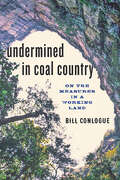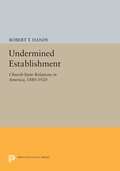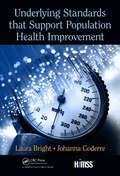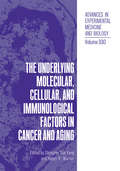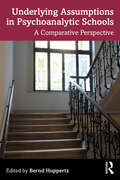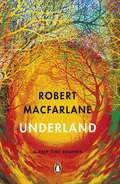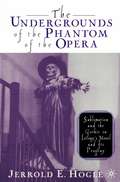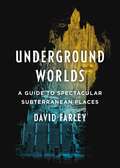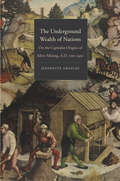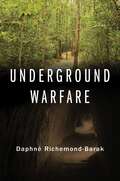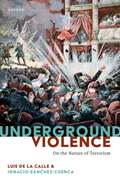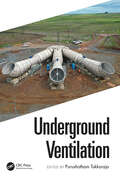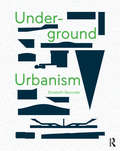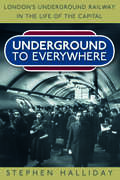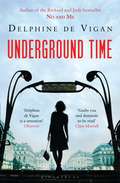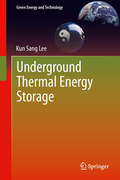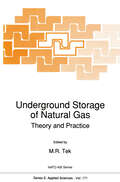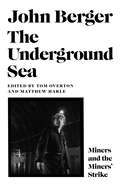- Table View
- List View
Undermined in Coal Country: On the Measures in a Working Land
by Bill ConlogueDeep mining ended decades ago in Pennsylvania;€™s Lackawanna Valley. The barons who made their fortunes have moved on. Low wages and high unemployment haunt the area, and the people left behind wonder whether to stay or seek their fortunes elsewhere.Bill Conlogue explores how two overlapping coal country landscapes;¢;‚¬;€?Scranton, Pennsylvania, and Marywood University;¢;‚¬;€?have coped with the devastating aftermath of mining. Examining the far-reaching environmental effects of mining, this beautifully written book asks bigger questions about what it means to influence a landscape to this extent;¢;‚¬;€?and then to live in it. In prose rivaling that of Annie Dillard and John McPhee, Conlogue argues that, if we are serious about solving environmental problems, if we are serious about knowing where we are and what happens there, we need to attend closely to all places;¢;‚¬;€?that is, to attend to the world in a cold, dark, and disorienting universe. Unearthing new ways of thinking about place, pedagogy, and the environment, this meditative text reveals that place is inherently unstable.
Undermined Establishment: Church-State Relations in America, 1880-1920
by Robert T. HandyIn the middle of the nineteenth century, a stable relationship between American religious organizations and the state was taken for granted. Concord prevailed between the Christian (and largely Protestant) "establishment" on one side and governmental bodies on the other. Here a preeminent scholar of American religious history shows what happened when that settled relationship was tested and challenged. The decades from 1880 to 1920 were marked by an unprecedented influx of immigrants (many of whom were Catholics and Jews), increasing conflicts between public and private school systems, excitement over imperialism, the growth of progressivism in politics, the rise of the social gospel, and the impact of World War I. Providing an overview of how these developments affected church-state relationships, Robert Handy's work is fascinating as a view of this period and as a clue to the tensions in American church-state relations today. Handy shows that the movement from a Protestant America to an explicit pluralism was well under way during these years, even though this change was not clearly recognized at the time it was occurring. Both governmental and religious institutions were transformed, and the difficult process of sorting out ways to relate them has been going on ever since. This book will be an invaluable aid in that task, for students of church-state relations and for a broader readership concerned with American culture in general.Originally published in 1991.The Princeton Legacy Library uses the latest print-on-demand technology to again make available previously out-of-print books from the distinguished backlist of Princeton University Press. These editions preserve the original texts of these important books while presenting them in durable paperback and hardcover editions. The goal of the Princeton Legacy Library is to vastly increase access to the rich scholarly heritage found in the thousands of books published by Princeton University Press since its founding in 1905.
Underlying Standards that Support Population Health Improvement (HIMSS Book Series)
by Laura Bright Johanna GoderreThis book highlights success stories and challenges to implementing health IT standards. The narrative of each chapter demonstrates how standards further interoperable health data exchange, especially in the service of advancing tools to monitor population health. These are critical stories that demonstrate to an international community of health and IT experts how to bring the right stakeholders together and bridge classic divides between software architects and clinical end users, health system decision-makers and standard authors.
Underlying Standards that Support Population Health Improvement (HIMSS Book Series)
by Laura Bright Johanna GoderreThis book highlights success stories and challenges to implementing health IT standards. The narrative of each chapter demonstrates how standards further interoperable health data exchange, especially in the service of advancing tools to monitor population health. These are critical stories that demonstrate to an international community of health and IT experts how to bring the right stakeholders together and bridge classic divides between software architects and clinical end users, health system decision-makers and standard authors.
The Underlying Molecular, Cellular and Immunological Factors in Cancer and Aging (Advances in Experimental Medicine and Biology #330)
by Stringer Sue YangBackground Cancer is a variety of malignancies generally associated with aging. As the overall health technology and health care delivery improved with the advances made in medicine and science in the United States, the life expectancy of the population also increased. The average life expectancy in the U. S. A. has increased from 49 years at the end of 1900 to 75 years today in 1990 (1-3). The population of 65 years and older that constituted 25. 5 million or 11. 3% of the total U. S. population in 1980(4) has now increased to 31. 1 million or 12. 5% of the population according to the 1990(5) census. As cancer diagnosis and treatment have improved, cancer mortality among patients under 55 has been significantly reduced within recent years *1; however, cancer incidence under 55 is still increasing at about 0. 4% per year (as compared to 1. 0% for all ages or 0. 6% for < 65) according to the 1990 review of the 15 year trends in the Cancer Statistics Review 1973-1987, published by the Surveillance, Epidemiology, and End Results (SEER) Program of the National Cancer Institute (NCI). In contrast, both cancer incidence and mortality have been increasing among the population 65 and over*2 at a rate of 1. 4% and 1. 0% respectively per year between 1973-1987(6).
Underlying Assumptions in Psychoanalytic Schools: A Comparative Perspective
by Bernd HuppertzThis book offers a comparative study of the major schools of psychoanalysis by exploring their historical development, their differences and similarities, and the underlying assumptions made by each. Encompassing the expertise of colleagues from different schools of psychoanalytic thought, each chapter explores a particular perspective, defining specific theoretical assumptions, theories of etiology, and implications for technique, as well as providing each author’s view on the historical development of key psychoanalytic concepts. With contributions from leading authors in the field, and covering both historical and international schools, the book provides an enlightening account that will prove essential to psychoanalytic practitioners and students of psychoanalysis and the history of medicine.
Underlying Assumptions in Psychoanalytic Schools: A Comparative Perspective
This book offers a comparative study of the major schools of psychoanalysis by exploring their historical development, their differences and similarities, and the underlying assumptions made by each. Encompassing the expertise of colleagues from different schools of psychoanalytic thought, each chapter explores a particular perspective, defining specific theoretical assumptions, theories of etiology, and implications for technique, as well as providing each author’s view on the historical development of key psychoanalytic concepts. With contributions from leading authors in the field, and covering both historical and international schools, the book provides an enlightening account that will prove essential to psychoanalytic practitioners and students of psychoanalysis and the history of medicine.
Underland: A Deep Time Journey
by Robert MacfarlaneThe unmissable new book from the bestselling, prize-winning author of Landmarks, The Old Ways and The Lost Words'You'd be crazy not to read this book' The Sunday Times'Underland is a magnificent feat of writing, travelling and thinking that feels genuinely frontier pushing, unsettling and exploratory' Evening Standard'Marvellous... Neverending curiosity, generosity of spirit, erudition, bravery and clarity... This is a book well worth reading' The Times'Extraordinary... at once learned and readable, thrilling and beautifully written' Observer'Attentive, thoughtful, finely honed... I turned the last page with the unusual conviction of having been in the company of a fine writer who is - who must surely be - a good man' TelegraphDiscover the hidden worlds beneath our feet...In Underland, Robert Macfarlane takes a dazzling journey into the concealed geographies of the ground beneath our feet - the hidden regions beneath the visible surfaces of the world. From the vast below-ground mycelial networks by which trees communicate, to the ice-blue depths of glacial moulins, and from North Yorkshire to the Lofoten Islands, he traces an uncharted, deep-time voyage. Underland a thrilling new chapter in Macfarlane's long-term exploration of the relations of landscape and the human heart.'He is the great nature writer, and nature poet, of this generation' Wall Street Journal 'Packed with stories based in geography, history, myth, gossip, legend, religion, geology and the natural world. Macfarlane's writing moves and enthrals' The Times on The Old Ways'Irradiated by a profound sense of wonder... Few books give such a sense of enchantment; it is a book to give to many, and to return to repeatedly' Independent on Landmarks
The Undergrounds of the Phantom of the Opera: Sublimation and the Gothic in Leroux's Novel and its Progeny
by J. HogleThis is the most comprehensive analytical study ever done of The Phantom of the Opera in its many different versions from the original Gaston Leroux novel to the present day. It proposes answers to the question, 'why do we keep needing this story told and retold in the Western world?' by revealing the history of deep cultural tensions that underlie the novel and each major adaptation. Using extensive historical and textual evidence and drawing on perspectives from several theories of cultural study, this book argues that we need this tale told and reconfigured because it provides us ways to both confront and disguise how we have fashioned our senses of identity in the Western middle class. The Phantom of the Opera - in varying ways over time - turns out like the 'Gothic' tradition it extends, to be deeply connected to Western self-fashioning in the face of conflicted attitudes about class, gender, race, religious beliefs, Freudian psychology, economic and international tensions, and especially the shifting and permeable boundaries between 'high' and 'low' culture. This book should interest all students of the history of Western culture, as well as those especially fascinated by Gothic fiction, opera, musical theatre, and film.
Underground Worlds: A Guide to Spectacular Subterranean Places
by David FarleyA visual and anecdotal exploration of the curious worlds hidden beneath our feet, including ancient cities, salt mine cathedrals, underground amusement parks, and more.From bone-filled catacombs to sculpted salt churches to hand-carved cave complexes large enough to house 20,000 people, Underground Worlds is packed with more than 50 unusual destinations that take some digging to find. Award-winning travel writer David Farley revels in the unexpected, whether it is a cave city in China which houses one of the world's largest collections of Buddhist art or an old salt mine converted into a theme park in Romania.Stunning photos help readers see places they could not even imagine, such as a three-story underground train station in Taiwan that is home to the a 4,500-panel "Dome of Light" that is the largest glasswork on Earth, as well as secret spaces, such as an ornate temple built beneath a suburban home in Italy. Throughout the fascinating text are themed entries of underground systems such as the 2,500-year-old water tunnels of Kish Qanat in Iran or engineering marvels like the New York City steam tunnels.
Underground Worlds: A Guide to Spectacular Subterranean Places
by David FarleyA visual and anecdotal exploration of the curious worlds hidden beneath our feet, including ancient cities, salt mine cathedrals, underground amusement parks, and more. From bone-filled catacombs to sculpted salt churches to hand-carved cave complexes large enough to house 20,000 people, Underground Worlds is packed with more than 50 unusual destinations that take some digging to find. Award-winning travel writer David Farley revels in the unexpected, whether it is a cave city in China which houses one of the world's largest collections of Buddhist art or an old salt mine converted into a theme park in Romania. Stunning photos help readers see places they could not even imagine, such as a three-story underground train station in Taiwan that is home to the a 4,500-panel "Dome of Light" that is the largest glasswork on Earth, as well as secret spaces, such as an ornate temple built beneath a suburban home in Italy. Throughout the fascinating text are themed entries of underground systems such as the 2,500-year-old water tunnels of Kish Qanat in Iran or engineering marvels like the New York City steam tunnels.
The Underground Wealth of Nations: On the Capitalist Origins of Silver Mining, A.D. 1150-1450 (Yale Series in Economic and Financial History)
by Jeannette GraulauSilver mining was a capitalist business long before the supposed origin of modern capitalism Hundreds of years before a sixteenth†‘century crisis in European agriculture led to the origins of capital, investment, and finance, the silver mining industry exhibited many of the features of modern capitalism. Silver mines were large†‘scale businesses that demanded large investments and steady cash flow, achieved by spreading that risk through fungible shares and creating legal structures to protect entrepreneurs from financial disaster. Jeannette Graulau argues that mining preceded agriculture as the first true capitalist enterprise of the modern world.
Underground Warfare
by Daphné Richemond-BarakUnderground warfare, a tactic of yesteryear, has re-emerged as a global and rapidly diffusing threat. This book is the first of its kind to examine tunnel warfare in a systematic and comprehensive way, addressing the legal issues while keeping in mind operational and strategic challenges. Like many other aspects of contemporary warfare, the renewed use of the subterranean in armed conflict presents a challenge for democracies wishing to abide by the law. To Dr. Richemond-Barak, this challenge has not only been under-explored, it is also largely underestimated by the community of states, security experts, and public opinion. She analyzes traditional concepts of the laws of war as they relate to tunnels and underground operations, contemplating questions such as whether tunnels constitute legitimate targets, the assessment of proportionality in anti-tunnel operations, and the availability of advanced warning in this complex terrain. She also identifies issues that are unique to underground warfare, including those that arise when cross-border tunnels burrow under a state's own civilian infrastructure.
Underground Warfare
by Daphné Richemond-BarakUnderground warfare, a tactic of yesteryear, has re-emerged as a global and rapidly diffusing threat. This book is the first of its kind to examine tunnel warfare in a systematic and comprehensive way, addressing the legal issues while keeping in mind operational and strategic challenges. Like many other aspects of contemporary warfare, the renewed use of the subterranean in armed conflict presents a challenge for democracies wishing to abide by the law. To Dr. Richemond-Barak, this challenge has not only been under-explored, it is also largely underestimated by the community of states, security experts, and public opinion. She analyzes traditional concepts of the laws of war as they relate to tunnels and underground operations, contemplating questions such as whether tunnels constitute legitimate targets, the assessment of proportionality in anti-tunnel operations, and the availability of advanced warning in this complex terrain. She also identifies issues that are unique to underground warfare, including those that arise when cross-border tunnels burrow under a state's own civilian infrastructure.
Underground Violence: On the Nature of Terrorism
by Luis de la Calle Ignacio S??nchez-CuencaWhat makes terrorism a unique form of political violence is its underground nature. According to the conceptualization of the phenomenon offered in this book, terrorism is the kind of violence carried out when the perpetrators lack territorial control. There is a strong link between terrorism and secret, clandestine operations, making terrorists attacks ephemeral, as opposed to battles and assaults. The book offers a comprehensive conceptual analysis of terrorism, comparing it with competing theories and views on the subject, such as terrorism is killing civilians, or terrorism is a form of violence that relies on the distinction between direct and indirect targets. The conceptualization advanced here makes sense of some peculiar traits of terrorism, from international attacks (in which the underground constraint is most obvious), to lone-actor ones (in which a single individual commits a deed). It also delimits the possibility of state terrorism as covert operations by security forces, normally abroad. Approaching terrorism in terms of the underground not only makes sense of how we talk about terrorism, but it also generates testable consequences. Through a combination of statistical and comparative analyses, it is shown that the use of terrorism is driven by the degree of asymmetry between the contending parties.
Underground Violence: On the Nature of Terrorism
by Luis de la Calle Ignacio S??nchez-CuencaWhat makes terrorism a unique form of political violence is its underground nature. According to the conceptualization of the phenomenon offered in this book, terrorism is the kind of violence carried out when the perpetrators lack territorial control. There is a strong link between terrorism and secret, clandestine operations, making terrorists attacks ephemeral, as opposed to battles and assaults. The book offers a comprehensive conceptual analysis of terrorism, comparing it with competing theories and views on the subject, such as terrorism is killing civilians, or terrorism is a form of violence that relies on the distinction between direct and indirect targets. The conceptualization advanced here makes sense of some peculiar traits of terrorism, from international attacks (in which the underground constraint is most obvious), to lone-actor ones (in which a single individual commits a deed). It also delimits the possibility of state terrorism as covert operations by security forces, normally abroad. Approaching terrorism in terms of the underground not only makes sense of how we talk about terrorism, but it also generates testable consequences. Through a combination of statistical and comparative analyses, it is shown that the use of terrorism is driven by the degree of asymmetry between the contending parties.
Underground Ventilation: Proceedings of the 19th North American Mine Ventilation Symposium ((NAMVS 2023, 17-22 June 2023, Rapid City, South Dakota, USA)
by Purushotham TukkarajaUnderground Ventilation contains the proceedings of the 19th North American Mine Ventilation Symposium held at the South Dakota School of Mines & Technology (South Dakota Mines) in Rapid City, South Dakota, June 17-22, 2023. South Dakota Mines organized this symposium in collaboration with the Underground Ventilation Committee (UVC) of the Society for Mining, Metallurgy & Exploration (SME). The Mine Ventilation Symposium series has always been a premier forum for ventilation experts, practitioners, educators, students, regulators, and suppliers from around the world to exchange knowledge, ideas, and opinions. Underground Ventilation features sixty-seven selected technical papers in a wide range of ventilation topics including: auxiliary and primary systems, mine fans, case studies, computational fluid dynamics applications, diesel particulate control, electric machinery, mine cooling and refrigeration, mine dust monitoring and control, mine fires and explosion prevention, mine gases, mine heat, mine ventilation and automation, occupational health and safety, renewable/alternative energy, monitoring and measurement, network analysis and optimization, and planning and design.
Underground Ventilation: Proceedings of the 19th North American Mine Ventilation Symposium ((NAMVS 2023, 17-22 June 2023, Rapid City, South Dakota, USA)
Underground Ventilation contains the proceedings of the 19th North American Mine Ventilation Symposium held at the South Dakota School of Mines & Technology (South Dakota Mines) in Rapid City, South Dakota, June 17-22, 2023. South Dakota Mines organized this symposium in collaboration with the Underground Ventilation Committee (UVC) of the Society for Mining, Metallurgy & Exploration (SME). The Mine Ventilation Symposium series has always been a premier forum for ventilation experts, practitioners, educators, students, regulators, and suppliers from around the world to exchange knowledge, ideas, and opinions. Underground Ventilation features sixty-seven selected technical papers in a wide range of ventilation topics including: auxiliary and primary systems, mine fans, case studies, computational fluid dynamics applications, diesel particulate control, electric machinery, mine cooling and refrigeration, mine dust monitoring and control, mine fires and explosion prevention, mine gases, mine heat, mine ventilation and automation, occupational health and safety, renewable/alternative energy, monitoring and measurement, network analysis and optimization, and planning and design.
Underground Urbanism
by Elizabeth ReynoldsHave you ever wondered what lies beneath the streets of your city? Do you picture, in isolation, a series of train tunnels and pipes? Or perhaps the foundations of tall buildings that lie scattered, like icebergs, beneath the surface? As our cities grow up, out, and down, it is time we better understood how the different layers of these complex urban environments relate to one another. Underground Urbanism seeks to provide a new perspective on our cities, and consider how this might be used to engage more positively with them. So, tip your cities upside down to have a closer look, and let us rethink them from (below) the ground, up.
Underground Urbanism
by Elizabeth ReynoldsHave you ever wondered what lies beneath the streets of your city? Do you picture, in isolation, a series of train tunnels and pipes? Or perhaps the foundations of tall buildings that lie scattered, like icebergs, beneath the surface? As our cities grow up, out, and down, it is time we better understood how the different layers of these complex urban environments relate to one another. Underground Urbanism seeks to provide a new perspective on our cities, and consider how this might be used to engage more positively with them. So, tip your cities upside down to have a closer look, and let us rethink them from (below) the ground, up.
Underground to Everywhere: London's Underground Railway in the Life of the Capital
by Stephen HallidayLondon's Underground is one of the best-known and most distinctive aspects of the city. Since Victorian times, this remarkable feat of engineering has made an extraordinary contribution to the economy of the capital and played a vital role in the daily life of generations of Londoners. Stephen Halliday’s informative, entertaining, wide-ranging history of the Underground celebrates the vision and determination of the Victorian Pioneers who conceived this revolutionary transport system. His book records the scandal, disappointments, and disasters that have punctuated the story and the careers of the gifted, dedicated, sometimes corrupt individuals that have shaped its history. It also gives a fascinating insight into the neglected, often unseen aspects of this subterranean system - the dense network of tunnels, shafts and chambers that have been created beneath the city streets.
Underground Time
by Delphine De ViganEveryday Mathilde takes the Metro, then the commuter train to the office of a large multi-national where she works in the marketing department. Every day, the same routine, the same trains. But something happened a while ago - she dared to voice a different opinion from her moody boss, Jacques. Bit by bit she finds herself frozen out of everything, with no work to do. Thibault is a paramedic. Every day he drives to the addresses he receives from his controller. The city spares him no grief: traffic jams, elusive parking spaces, delivery trucks blocking his route. He is well aware that he may be the only human being many of the people he visits will see for the entire day and is well acquainted with the symptomatic illnesses, the major disasters, the hustle and bustle and, of course, the immense, pervading loneliness of the city.Before one day in May, Mathilde and Thibault had never met. They were just two anonymous figures in a crowd, pushed and shoved and pressured continuously by the loveless, urban world.Underground Time is a novel of quiet violence - the violence of office-bullying, the violence of the brutality of the city - in which our two characters move towards an inevitable meeting. 'Two solitary existences cross paths in this poignant chronicle, a new testimony to de Vigan's superb eloquence' Lire
Underground Thermal Energy Storage (Green Energy and Technology)
by Kun Sang LeeUnderground thermal energy storage (UTES) provide us with a flexible tool to combat global warming through conserving energy while utilizing natural renewable energy resources. Primarily, they act as a buffer to balance fluctuations in supply and demand of low temperature thermal energy. Underground Thermal Energy Storage provides an comprehensive introduction to the extensively-used energy storage method. Underground Thermal Energy Storage gives a general overview of UTES from basic concepts and classifications to operation regimes. As well as discussing general procedures for design and construction, thermo-hydro geological modeling of UTES systems is explained. Finally, current real life data and statistics are include to summarize major global developments in UTES over the past decades. The concise style and thorough coverage makes Underground Thermal Energy Storage a solid introduction for students, engineers and geologists alike.
Underground Storage of Natural Gas: Theory and Practice (NATO Science Series E: #171)
by M.R. TekThis book contains the proceedings of NATO Advanced Study Institute, 'Underground Storage of Natural Gas - Theory and Practice', which was held at The Middle East Technical University, Ankara, Turkey during 2-10 May 1988. Underground storage is the process which effectively balances a variable demand market with a desirably constant supply provided by pipelines. Storage reservoirs are the unique warehouses designed and developed to provide a ready supply of natural gas in response to high, peak demands during cold weather. The natural' gas is injected into the underground storage environment when the market demand falls below the supply available from the pipeline. It is withdrawn from the storage reservoir to supplement the steady supply provided by the pipelines whenever the demand exceeds the supply. The overall wellbeing of the entire western world in general and of the NATO member count ries in particular depend critically upon having sufficient energy resources. Of over 80 quad Btus of energy consumed each year in the western world, about 30~ comes from natural gas, a figure only exceeded by oil. The technology related to supply and demand of natural gas has been in the focus of long range energy planning during the last decade in Western Europe. In view of recent developments related to natural gas in Europe and Turkey, an "Advanced Study Institute" programme in Turkey on underground storage of natural gas was deemed particularly relevant and timely.
The Underground Sea
by John BergerThe Underground Sea is a succinct, urgent collection of writing from John Berger’s archive. It brings together for the first time his work on mineworkers and the miners’ strikes and has been edited as a set of actions for today. Publication of The Underground Sea marks the 40th Anniversary of the 1984-5 Strike, at a time when people are rediscovering the necessity, power and possibilities of collective action. Including transcripts and image-essay of his rarely-seen BBC programme, Germinal; interviews and his essay ‘Miners’, it places itself in the heart of a Derbyshire mining village, with reflections on the everyday life of a typical pit community. Berger grapples with the politics of witness as he studies the miners’ labour and the wider community shaped in service to this work. Reflecting on their precarity, he goes back to Zola’s novel for hope that ‘a new world is germinating underneath the ground. And when it arrives, it will crack open the earth.’
